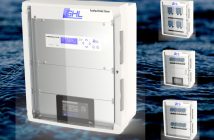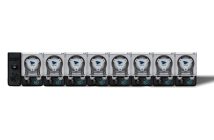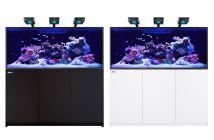Please join us in welcoming our newest AquaNerd Contributor Raul Roman as he explains how to avoid making the typical newbie mistakes in aquarium equipment purchasing, something we could all appreciate at one time in our hobby or another.
Like many hobbyists, it was money that kept me from initially buying the proper equipment. It is ironic that in the end I probably spent more in the long run. If you factor in the modifications, upgrades, loss of livestock, loss of your valuable time and just plain old grief caused by the purchase of woefully inadequate equipment, then it’s pretty safe to say that you would have been better off getting the right thing from the get-go. If you made the same mistakes as I, then enjoy the nostalgic trip and try not to laugh too much. If, however, you are a newbie getting ready to make some of these decisions, then pay close attention and learn from those that have come before you. Now, that’s not to say that I think that everyone of these 5 things is a must for every single scenario, but I believe them to be fairly universal in their importance in getting it right the first time.
1) Metal Halide Lighting With a Good Reflector
I started with Power Compact florescent lights and later upgraded to T5s, but I was never really happy until I installed a Metal Halide fixture. Are you happy with the growth you are getting from your corals? Are you happy with the color of your reef? Have you wanted to buy a beautiful clam but thought otherwise because you knew it wouldn’t thrive under your current lighting? Are you tired of swapping out eight T5 bulbs every 6 months? I know I was! Cost is what keeps most of us from going with Metal Halide lighting (heat, energy efficiency also to be considered by some) but as I found out from experience, it is not as expensive as it first sounds, particularly if you are willing to roll up your sleeves and engage in a little DIY ingenuity. I ultimately installed a retrofit Metal Halide kit which included a reflector, remote ballast and all the wiring needed to make the needed connections. You don’t have to be an electrician to tackle one of these projects, particularly if you go with a self-contained ballast box. My only advice here would be to consider the added heat produced by Metal Halide lighting into your decision and get ready to never again having to pass up on a livestock purchase because of questions about your lighting’s suitability.
2) A Properly Sized Sump
My first setup was sump-less, meaning all filtration and equipment resided in the display. It was very hard to make this look good and I could never satisfactorily manage the unsightly and light-robbing protein film that floated on top of the water column. I run across these posts on reef forums all the time (show me your sump-less setup, for example) and some folks make a good go of it, but why put up with the extra hassle of trying to find the right hang-on equipment, then trying to hide it as best as possible so as to not distract from your tank’s display? A sump doesn’t come without its drawbacks, but it is my opinion that a sump greatly enhances your filtration system’s capabilities while letting your display worry about just housing your livestock in the most visually appealing manner. You might have noticed that I qualified the need for a sump with the words “properly sized” and this is most important because you want one that is big enough to capture the water that will siphon from the display in the event of a power failure. Neglect this consideration and you will eventually have a messy flood on your hands. A properly sized sump will also easily accommodate all of your filtration equipment with the added room for growth should you choose to add extra filtration equipment at a later time.
3) A Quality Protein Skimmer
I initially tried to make do without a protein skimmer. This is not a rare decision for a person who is trying to get over the shell-shock of the prices of some of the equipment suggested by fellow reefers and LFS staff. Can you run a reef tank without a skimmer? Of course you can, but why put yourself through the hassle of frequent large water changes, the constant concern that you are feeding too much and the overuse of expensive, trace element-robbing, chemical filtration media. I finally purchased a hang-on skimmer that was fairly cheap (<$200) but also highly inefficient for the task of filtering my tank’s water. Coming to know my skimmer’s shortcomings, I proceeded to scour the web looking for “mods” to enhance my skimmer’s performance. There is nothing wrong with this practice in general, but at some point some of us should come to the realization that it’s just not worth the hassle if in the end you still end up with a skimmer that isn’t getting the job done. A skimmer’s adequacy for your reef is best determined by following the manufacturer’s recommendations (this wasn’t always the case in the past, but today’s recommendations are much better) and by getting the opinions of actual owners with similar setups to your own. A good skimmer isn’t usually cheap, but it also doesn’t have to break the bank, so do your homework.
4) A Tank With a Built-in Overflow
Once I implemented a sump on my reef tank, I was forced to use a hang-on box type overflow with the infamous U-tube water transport design. These have their place, but I’m so glad I no longer have to start the U-tube siphon or deal with trapped bubbles slowing down the overflow’s throughput, or worse yet the often encountered rogue snail that clogs up the works and too often leads to a messy flood. A good built-in overflow can make many of the above scenarios a thing of the past. Other advantages of the built-in overflow include the more aesthetically pleasing form, their ability to draw water from the lower portion of the water column as well as from the surface and thus doing a better job of capturing that dreaded detritus.
5) The Chiller
This will perhaps be the most debated of my recommendations, but I find it an absolute must for those of us living in hotter climates. I live in Florida and high aquarium water temperatures were not as big of a problem when Power Compact lighting was my mode of lighting, but once I switched to metal halide lighting it became a full time job to keep my tanks temperature below 80 degrees (where I feel my tank does best). Yes I could have run my central air to keep the temperature under control but it seemed like such a waste to cool an entire home when no one was there just to keep my aquarium’s temp under 80 degrees. The implementation of various fans will help but they will only get you so far. I even went as far as changing out all my pumps to more efficient (less heat producing) models but I quickly found out that this approach, like the use of fans, will only get you down a couple of degrees in most situations. After all this hassle and expense ($400+ in fans and new pumps), I was still spiking 3 degrees above my desired temperature. What I ultimately learned was that a small chiller (one normally considered grossly undersized for your tank’s water volume) is more than capable of getting you to your desired goal by dropping the temperature 3 or 4 degrees if that is all that is needed. I ended up buying a 1/15 HP chiller to get my 150 gallon aquarium down by just a few degrees and thus letting me have the below 80 temperature that I desired. That chiller cost me $350 which is less than I spent on fans and pump upgrades. The best part of all is that a chiller is one of those set it and forget it type of devices. No more temperature worries for me! Do note that the cost of powering a chiller and the added heat produced by the device must be taken into account then determining their suitability for your particular setup.
As I always emphasize whenever I dole out advice, this is not an all encompassing recipe for success. There are an infinite number of variables and unique situations which may require a different approach so remember; it’s your reef, so study and execute as only you know best.





